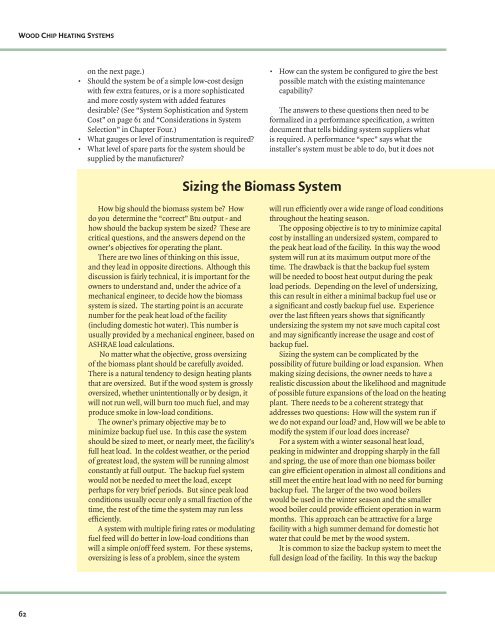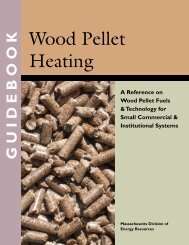Wood-Chip Heating Systems - Biomass Energy Resource Center
Wood-Chip Heating Systems - Biomass Energy Resource Center
Wood-Chip Heating Systems - Biomass Energy Resource Center
Create successful ePaper yourself
Turn your PDF publications into a flip-book with our unique Google optimized e-Paper software.
WOOD CHIP HEATING SYSTEMS<br />
62<br />
on the next page.)<br />
• Should the system be of a simple low-cost design<br />
with few extra features, or is a more sophisticated<br />
and more costly system with added features<br />
desirable? (See “System Sophistication and System<br />
Cost” on page 61 and “Considerations in System<br />
Selection” in Chapter Four.)<br />
• What gauges or level of instrumentation is required?<br />
• What level of spare parts for the system should be<br />
supplied by the manufacturer?<br />
How big should the biomass system be? How<br />
do you determine the “correct” Btu output - and<br />
how should the backup system be sized? These are<br />
critical questions, and the answers depend on the<br />
owner’s objectives for operating the plant.<br />
There are two lines of thinking on this issue,<br />
and they lead in opposite directions. Although this<br />
discussion is fairly technical, it is important for the<br />
owners to understand and, under the advice of a<br />
mechanical engineer, to decide how the biomass<br />
system is sized. The starting point is an accurate<br />
number for the peak heat load of the facility<br />
(including domestic hot water). This number is<br />
usually provided by a mechanical engineer, based on<br />
ASHRAE load calculations.<br />
No matter what the objective, gross oversizing<br />
of the biomass plant should be carefully avoided.<br />
There is a natural tendency to design heating plants<br />
that are oversized. But if the wood system is grossly<br />
oversized, whether unintentionally or by design, it<br />
will not run well, will burn too much fuel, and may<br />
produce smoke in low-load conditions.<br />
The owner’s primary objective may be to<br />
minimize backup fuel use. In this case the system<br />
should be sized to meet, or nearly meet, the facility’s<br />
full heat load. In the coldest weather, or the period<br />
of greatest load, the system will be running almost<br />
constantly at full output. The backup fuel system<br />
would not be needed to meet the load, except<br />
perhaps for very brief periods. But since peak load<br />
conditions usually occur only a small fraction of the<br />
time, the rest of the time the system may run less<br />
effi ciently.<br />
A system with multiple fi ring rates or modulating<br />
fuel feed will do better in low-load conditions than<br />
will a simple on/off feed system. For these systems,<br />
oversizing is less of a problem, since the system<br />
Sizing the <strong>Biomass</strong> System<br />
• How can the system be confi gured to give the best<br />
possible match with the existing maintenance<br />
capability?<br />
The answers to these questions then need to be<br />
formalized in a performance specifi cation, a written<br />
document that tells bidding system suppliers what<br />
is required. A performance “spec” says what the<br />
installer’s system must be able to do, but it does not<br />
will run effi ciently over a wide range of load conditions<br />
throughout the heating season.<br />
The opposing objective is to try to minimize capital<br />
cost by installing an undersized system, compared to<br />
the peak heat load of the facility. In this way the wood<br />
system will run at its maximum output more of the<br />
time. The drawback is that the backup fuel system<br />
will be needed to boost heat output during the peak<br />
load periods. Depending on the level of undersizing,<br />
this can result in either a minimal backup fuel use or<br />
a signifi cant and costly backup fuel use. Experience<br />
over the last fi fteen years shows that signifi cantly<br />
undersizing the system my not save much capital cost<br />
and may signifi cantly increase the usage and cost of<br />
backup fuel.<br />
Sizing the system can be complicated by the<br />
possibility of future building or load expansion. When<br />
making sizing decisions, the owner needs to have a<br />
realistic discussion about the likelihood and magnitude<br />
of possible future expansions of the load on the heating<br />
plant. There needs to be a coherent strategy that<br />
addresses two questions: How will the system run if<br />
we do not expand our load? and, How will we be able to<br />
modify the system if our load does increase?<br />
For a system with a winter seasonal heat load,<br />
peaking in midwinter and dropping sharply in the fall<br />
and spring, the use of more than one biomass boiler<br />
can give effi cient operation in almost all conditions and<br />
still meet the entire heat load with no need for burning<br />
backup fuel. The larger of the two wood boilers<br />
would be used in the winter season and the smaller<br />
wood boiler could provide effi cient operation in warm<br />
months. This approach can be attractive for a large<br />
facility with a high summer demand for domestic hot<br />
water that could be met by the wood system.<br />
It is common to size the backup system to meet the<br />
full design load of the facility. In this way the backup





